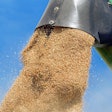
The U.S. Department of Agriculture's National Agricultural Statistics Service released its latest Grain Crushings and Co-Products Production report on June 2, revealing a mixed picture for the corn processing industry in April 2025.
Total corn consumed for alcohol and other uses reached 475 million bushels in April, marking a 6% decrease from March but a 1% increase compared to April 2024. The report indicates that 91.7% of this corn was used for alcohol production, with the remaining 8.3% allocated to other purposes.
Fuel alcohol production, a key driver of corn demand, utilized 426 million bushels in April. While this represents a 6% decline from March, it shows a 1% increase from the same period last year. The data highlights the continued importance of the ethanol industry in supporting corn markets.
Breaking down the fuel alcohol production, dry milling accounted for 91.5% of the corn used, with wet milling making up the remaining 8.5%. This distribution underscores the dominance of dry mill ethanol plants in the industry.
The report also shed light on co-product production, an essential aspect of the ethanol industry's economic viability. Distillers dried grains with solubles (DDGS), a valuable livestock feed, saw production fall to 1.63 million tons in April. This marks a 10% decrease from March and a 7% decline from April 2024, potentially signaling challenges in the feed market.
However, not all co-products experienced declines. Distillers wet grains (DWG) with 65% or more moisture saw a slight uptick, reaching 1.26 million tons in April. This represents a 3% increase from March and a 1% rise from the previous year.
In the wet milling sector, corn gluten feed production totaled 242,134 tons, down 7% from March but up 2% from April 2024. Wet corn gluten feed with 40 to 60% moisture saw a marginal increase of 1% from March, reaching 198,188 tons.
The fluctuations in corn consumption and co-product output reflect the dynamic nature of the ethanol industry, which continues to play a crucial role in U.S. agriculture and energy sectors. Industry stakeholders will likely monitor these trends closely, as they can impact corn prices, livestock feed markets, and overall profitability in the sector.

















